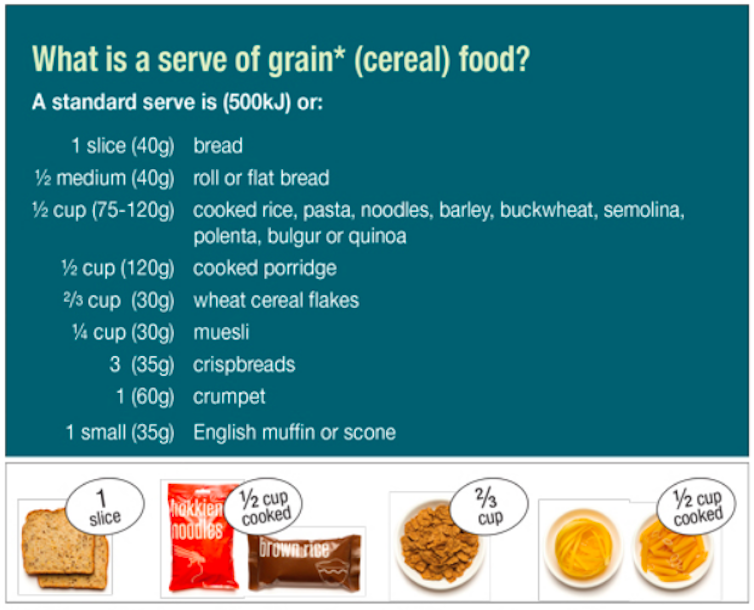How much food should my child be eating? And how can I get them to eat more healthily?
- Written by Clare Collins, Professor in Nutrition and Dietetics, University of Newcastle
Children need healthy food in the right amount so they get all the nutrients needed to grow, learn and thrive.
The Australian dietary guidelines outline the number of daily servings children need each day from each food group, based on their sex and age:
This is just a guide; your child’s needs will depend on their activity levels, but it’s good to get a sense of what you should be aiming for.
Keep in mind serving sizes vary for each of the five food groups. For example, here’s what constitutes a serve of grains:
 A sandwich would equal two serves.
NHMRC
A sandwich would equal two serves.
NHMRC
Choosing from five food groups sounds simple enough. But supermarkets can carry up to 30,000 products. Many foods are heavily marketed and it’s rarely the healthy ones.
So children end up eating more junk foods and fewer fruits and vegetables than recommended. A 2011-12 survey of two to 18 year olds found 38% of children’s average total energy intake came from junk foods. Cakes, muffins, slices, biscuits, chips, packet snacks, processed meats and sugary drinks were the main contributors.
In 2017-18, just one in 17 children aged two to 17 years ate the recommended daily serves of vegetables.
So how do you get kids to eat less junk and more healthy food?
Say no to junk foods
While young children can recognise healthy foods fairly easily, they find it hard to know which foods are energy-dense, nutrient-poor “junk” foods.
The foods available in your home act as a powerful signpost to your children about what to eat. When there are unhealthy snack foods in the pantry children (and adults) eat more of them.
Read more: What is a balanced diet anyway?
Unfortunately, it’s hard for parents to avoid some messages their children receive around food, especially from advertising.
But try to ignore those requests; eventually your child will stop asking. A survey of 7,800 children found that kids who “often” asked for items advertised on TV were 30% more likely to become overweight during two years of follow-up.
 Children have a good sense of what’s healthy but are less clear about unhealthy foods.
Shutterstock
Children have a good sense of what’s healthy but are less clear about unhealthy foods.
Shutterstock
Avoid portion distortion
Keep a watch on the size of portions. Serving bigger amounts can lead to unconsciously eating more.
We reviewed portion sizes of common foods and drinks that children aged two to 16 years consumed, from 1995 to 2007.
We found typical portion sizes for cooked meat and chicken, mixed chicken dishes, bacon and ham, fish and pizza had increased.
Portion sizes decreased for most dairy products, breakfast cereals, vegetables and some packaged snacks.
Read more: Health check: do bigger portion sizes make you eat more?
Don’t let fussy eating derail healthy eating plans
It is common for children to go through a period of fussy eating with reports varying from one to three out of every five.
Kids’ appetites can vary a lot, particularly among toddlers who are more likely to only eat when they are hungry, regardless of whether it is meal time or not.
Strategies that help children eat healthily include learning by seeing what others do and having direct contact with foods through touch, taste and smell.
Read more: How to tell if your kid's 'fussy eating' phase is normal
Try to have set meal and snack times (breakfast, lunch and dinner and two to three snacks) and offer children foods from each of the food groups daily. If a child isn’t hungry at that time, wait until the next scheduled meal or snack and offer food then.
At the dinner table focus on the behaviours you want to see. Do this by praising the child who is trying the meal and tasting new foods. For example, “I love the way you tasted that eggplant”.
Finally, plan inexpensive meals that do not take long to prepare and that children can feed themselves, such as those on the No Money No Time website.
 Encourage children to experiment with different foods.
Shutterstock
Encourage children to experiment with different foods.
Shutterstock
Want more information on nutrition for kids?
We have developed two free three-week Massive Open Online Courses (MOOCs).
Food for Kids: Discovering Healthy Eating is an interactive course designed for primary school aged children. Topics include: what’s in food; how it gets digested in the body; identifying healthy food and drinks; and reducing food waste.
Food for Kids: A Parent’s Guide is designed for parents, teachers and everyone interested in child nutrition. Topics include: how food and drinks influence growth and development; which foods and how much are needed for children to meet nutrition guidelines; and how to develop healthy household eating habits.
Courses start March 4 but you can enrol any time during the course, once it starts.
If you want to know how your child’s current dietary patterns rate, and are looking for some specific tips to improve their nutrition, you can do the Healthy Eating Quiz here.
Read more: Five things parents can do to improve their children's eating patterns
Authors: Clare Collins, Professor in Nutrition and Dietetics, University of Newcastle




